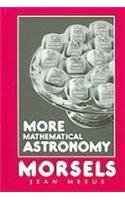

Most ebook files are in PDF format, so you can easily read them using various software such as Foxit Reader or directly on the Google Chrome browser.
Some ebook files are released by publishers in other formats such as .awz, .mobi, .epub, .fb2, etc. You may need to install specific software to read these formats on mobile/PC, such as Calibre.
Please read the tutorial at this link: https://ebookbell.com/faq
We offer FREE conversion to the popular formats you request; however, this may take some time. Therefore, right after payment, please email us, and we will try to provide the service as quickly as possible.
For some exceptional file formats or broken links (if any), please refrain from opening any disputes. Instead, email us first, and we will try to assist within a maximum of 6 hours.
EbookBell Team

5.0
50 reviews
ISBN 10: 0943396514
ISBN 13: 9780943396514
Author: Jean Meeus
1.THE MOON
The Harvest Moon
About the Moon’s elongation
The age of the Moon
The duration of the lunation
About the Metonic Cycle
Extreme perigees and apogees of the Moon
The brightest Full Moon and the phase effect
2.ECLIPSES AND OCCULTATIONS
The calculation of solar eclipses
Three special annular solar eclipses
The number of total solar eclipses per year
Solar eclipses and calendar months
Solar and lunar eclipses at a given place
Total solar eclipses per country
Three total solar eclipses in a short interval
Painted Globe
Long eclipseless periods
Total solar eclipses of long duration
About the smallest “single” solar eclipse
Is a non-central annular-total solar eclipse possible?
The extinction of total solar eclipses
Solar eclipses: Duos and Double Duos
Christmas eclipses
The Wednesday enigma
Lunar eclipses of long duration
Lunar eclipses on Easter Sunday
Simultaneous occultations of planets
Occultations of deep-sky objects during a total lunar eclipse
Occultations of bright stars by planets
Occultations of bright stars by minor planets
Mutual occultations of planets
Mutual occultations of minor planets
Eclipses of the satellites of Saturn
3.PLANETARY MOTIONS
Long-period variations of the orbit of the Earth
Long-period variations of the orbit of Venus
Long-period variations of the orbit of Mars
Mars’ closest approaches to Earth
The recovery of Albert
Cruithne, an asteroid with a remarkable orbit
Evolution of two cometary orbits
The motion of a satellite with respect to the Sun
4.PLANETARY PHENOMENA
About some planetary conjunctions
About the Venus-Jupiter conjunctions
Close planet-star conjunctions
The Jupiter-Regulus conjunctions
Venus and the Pleiades
Planetary groupings
Illuminated fraction and greatest elongation
Transits of Mercury – panoramas and partial transits
Jupiter without satellites, 1600-1799
On the changing aspect of Saturn’s ring
Equinoxes and solstices on Uranus and Neptune
Transits as seen from Pluto
5.ON THE CELESTIAL SPHERE
Sun and horizon
About the shortest day
Culmination and meridian transit
The greatest variation of the altitude
Pole and constellations
Zodiacal constellations
Precession, aberration & Co.
Proper motions and star patterns
All five planets simultaneously
Venus as evening and morning star
6.VARIA
The Gregorian calendar and the tropical year
Some special astronomical phenomena during the 21st century
The shortest and the longest twilight
The day of the year – a mathematical joke
Approximations
The effect of ΔT on astronomical calculations
The Simplex method and the least distance between two planetary orbits
Astronomical anomalies?
Some popular misconceptions
Incorrect definitions
Planets and radio disturbances
Peculiarities about minor planet names
About sunspot activity
more mathematical astronomy morsels jean meeus
more mathematical astronomy morsels pdf
mathematical astronomy morsels
more mathematical astronomical morsels
astronomers use a mathematical model called a
Tags: Jean Meeus, mathematical, astronomy